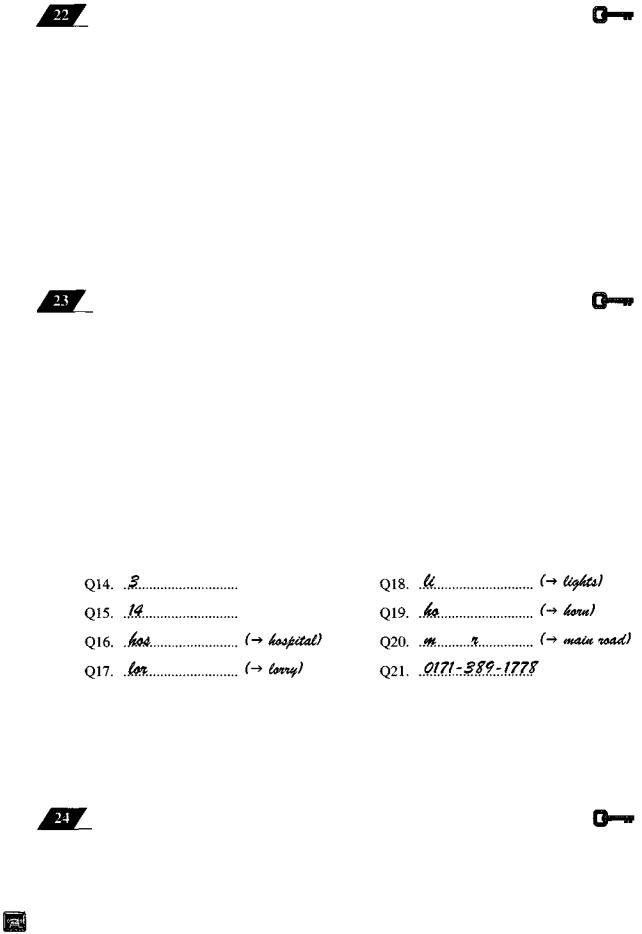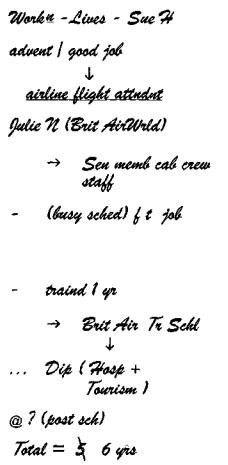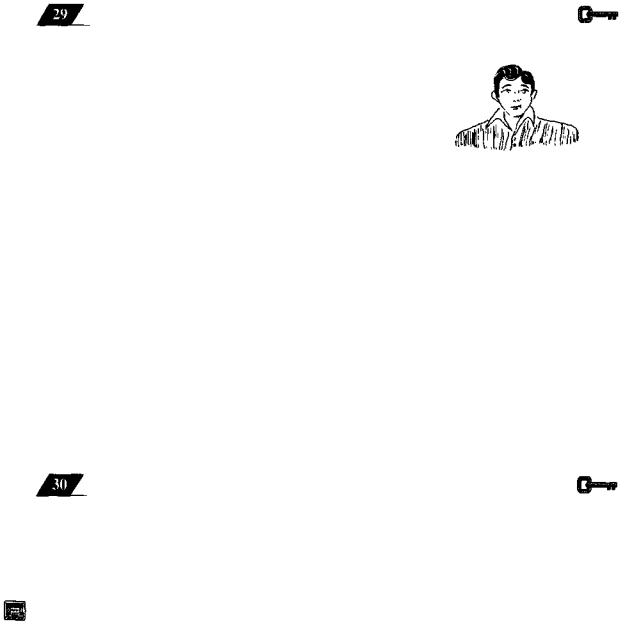
Helpful_Hints_for_IELTS
.pdf
Listening Test Hints
LISTEN FOR THE SPEAKER CHANGING HIS/HER MIND
Often the speaker changes his or her mind and makes a correction before giving the answer that you need. Alternatively, the speaker may correct someone else.
• Look at the part of the tapescript which answers Question 7 in Listening Test One:
Clerk: George ... er... L-A-V-I-L-L-I-E-R-S. Good. Now, nationality: French. No, wait a minute. It's a Swiss passport.
The clerk wants to find out George's nationality. He guesses that George is French, but thinks twice when he notices George's passport is Swiss. It would be a mistake to write down the first nationality mentioned, in your hurry to get the right answer.
Listen for the possibility of the speaker making corrections to what is said
USE SHORTHAND FOR SPEEDY WRITING
In the Listening Test, you are often required to listen for the next answer while writing down the answer to the previous question. It is one ofthe measures ofeffective listening - the examiners want to find out if you can comprehend what is said while attempting another task at the same time. This further tests your listening ability in English.
To write down the answers more quickly, write only the first two or three letters ofthe answer that you hear. This shorthand approach is effective in a gapfill listening taskbecause some ofthe answers may come in quick succession, especially at the beginning ofthe gapfill passage. (See also Listening Hints 24 and 25.) You can complete the words during the short period oftime given to you after the passage has finished. You are very likely to remember what the letters mean because they are the first letters of words you have recently heard in context.
• Look at Questions 14 - 21 in Listening Test One:
This method can enable you to return quickly to giving your whole attention to listening for the next answer. However, it does require some practice. Note that you would not try to use this method to remembernumbers, but with word answers you can almost always remember the words again. Then, all you need to do is give the correct grammatical form ofthe answers. (See also IELTS Test - Basic Hint 12.)
PRACTICE FOR LISTENING GAPFILLS
Gapfill tasks are usually considered by candidates to be the most difficult of the IELTS listening tasks. Your grammatical knowledge is as important as your listening ability, for answers should be grammatically correct within the given sentences.
The most common type of IELTS listening gapfill task requires you to listen to a passage of spoken English containing information concerning a particular topic or event. In the tests in this book both gapfill listening tasks are news items. It is good practice to listen to the news either on the TV or radio, and try to complete a chart such as the one on the next page:
23

101 Helpful Hints for IELTS
Item |
What? |
Where? |
When? |
Who? |
How? |
Why? |
|
|
|
|
|
|
|
News Item 1 |
|
|
|
|
|
|
|
|
|
|
|
|
|
News Item 2 |
|
|
|
|
|
|
|
|
|
|
|
|
|
Not only news items, but all kinds of informative talks can provide practice ofthis kind. First, w you should do here is listen for general information. This is essential because unless you < understand the general idea of what is being said, you will be unable to understand the spec information in the talk. Most listening gapfill questions require you to listen for specific informati
Make a video or audio cassette tape of your news items or talks from the TV or radio. Now go bj over the tape you have made and listen for specific information on the tape. It is useful to m an audio cassette ofa video cassette item because it is easier to play back the information on an au cassette tape. Do not try to understand every word. You should train your ear to listen for the wo you are already familiar with, but did not catch on the first listening for general information.
You can also use the passages on the audio cassette tape that accompanies this book for the ss purpose. Check the words that you miss by referring to the Practice Listening Test Tapescript Appendix 2 starting on page 153. More exercises are available from the companion practice bi
'202 Useful Exercisesfor IELTS'. (See also Reading Hint 55.)
LISTENING GAPFILLS - STEP BY STEP
•Before you listen:
Read the instructions carefully.
(See IELTS Test - Basic Hints 7 and 8.) Always look at and listen for the example.
(See IELTS Test - Basic Hint 9.)
•As you listen:
Choose the keywords/phrases to listen for, and be aware of the question changing. (See IELTS Test - Basic Hint 10 and Listening Hint 20.)
Be aware that some of the answers may come quickly one after the other. (See Listening Hint 23.)
Be aware that one or two of the answers may not be given in question order. (See Listening Hint 20.)
Be aware that the word or phrase you need may already be on the page. (See Listening Hint 21.)
Use shorthand to improve the speed at which you write down your answers. (See Listening Hint 23.)
D In the time given to you at the end of the gapfill:
Make sure your words and numbers are easy to read. (See IELTS Test - Basic Hints 14 and 15.)
Guess the answers to unanswered questions - do not leave blanks. (See IELTS Test - Basic Hint 11.)
Check that your answers are given in grammatically correct English. i.e. for answers that should be in plural form.
(See IELTS Test - Basic Hint 12.)
24

Listening Test Hints
PRACTICE FOR SHORT-ANSWER QUESTIONS
Some candidates find short-answer question tasks even more challenging than gapfill exercises. Usually, short-answer question tasks come later in the Listening Test, and, therefore, the Listening passages are longer and more difficult to understand.
The IELTS short-answer question tasks require you to listen to a passage of spoken English, often a conversation between two people, and choose words or phrases from the dialogue which best answer the given questions. It is good practice to listen to interviews and conversations with interesting persons on the TV or radio, and make brief notes from short excerpts of what you have chosen to listen to.
Make a video or audio cassette tape of your chosen news item or talk from the TV or radio. Now you can go back over the tape and make abbreviated notes of the important points made by the speakers. It is useful to make an audio cassette of a video cassette item because it is easier to play back the information on an audio cassette tape. Do not worry if you cannot understand every word.
You can also use the passages on the tape that accompanies this book for the same purpose. Check the words that you do not hear clearly by referring to the Practice Listening Test Tapescripts in Appendix 2 starting on page 153.
O Look at these notes made from part of the tapescript of Section 3 of Listening Test One:
Sue: Good afternoon and welcome to "Working Lives". My name is Sue Holt. This week we continue our series by looking at ajob that is often thought of as adventurous, exotic, and highly desirable. We're going to take a behind-the-scenes look at the airline hospitality industry. What is the reality behind the smart uniform and ever-ready smile of the flight attendant? We're lucky enough to have in the studio Julie Nevard, who works for British AirWorld, and is a senior member of the cabin crew staff.
Sue: Thank you for finding the time to speak to us. I know that you must have a busy schedule.
Julie: My pleasure. Yes, it is a very full-timejob, but I think you realise that very early on in your career..
Sue: How long have you been involved in in-flight hospitality?
Julie: Well, I trained for a year at the British AirWorld Training School, and... I'd already taken a Diploma in Hospitality and Tourism afterI left school so, all in all,
... about 5 years ... no, more like 6 years.
The notes above make use of abbreviations underlining
symbols, (especially dashes, arrows and brackets). missing vowels etc.
Be aware, however, that your test answers, must not be in note form. This is for practice only.
Forpractice, you can devise and use your own system ofnote-taking
25

101 Helpful Hints for IELTS
SHORT-ANSWER QUESTIONS - SPECIFY THE TOPIC |
O |
In a question which asks you to provide a short answer to a question, you should first accurately v out the question topic in order to give the correct answer.
•Look at Questions 24 and 25 in Listening Test One:
Q24. What does Julie like most about her job?
Q25. What is Julie's main responsibility when on duty?
In Question 24 the topic is not simply what Julie likes about herjob, but what Julie likes i about her job. Therefore, the answer is "meeting new people", and not "going to place, has never been before ", nor any of the other reasons she mentions.
Similarly, in Question 25 the topic is not simply Julie's responsibilities when on duty Julie's main responsibility when on duty. Therefore, the answer is "passenger comfort' not any one of the other responsibilities she mentions.
Check with the Practice Listening Test One Tapescript in Appendix 2 starting on page 1^ you are unsure of what Julie says.
If you do not read the question carefully, and do not accurately specify the topic, you might e give the wrong answer.
Before the passage is played, or as you listen, circle the topic ofeach questior
SHORT-ANSWER QUESTIONS - SUMMING UP |
Q |
The speaker often sums up what he or she says in answer to a specific question. It is natural speaker to be sometimes unable to give an instant answer to a question. The speaker will thei of many connected things before stating directly what he or she wishes to give as the answer; end of the reply.
• Look at part of the tapescript of Section 3 of Listening Test One:
Sue: Then tell me, what is your main responsibility during a flight?
Julie: That's hard to say really. Well, we're responsible for all the needs and demands of each and every passenger, for up to 10 hours on some long haul flights. Not to mention the safety of the plane and all the passengers. I suppose, if I have to come up with a single answer, it'd be passenger comfort.
The above excerpt gives the answer to Question 25 in Listening Test One.
Julie cannot instantly give a direct answer to Sue's question, but eventually sums up andher answer directly - "passenger comfort".
You should wait for the speaker to sum up before giving your short answer to a question. If y not, you run the risk of writing down an answer which may be incorrect or only partly correct might also be too busy writing down what you think is the answer, and not hear the correct ai in the speaker's summing up.
26

Listening Test Hints
SHORT-ANSWER QUESTIONS - STEP BY STEP
O Before you listen:
Read the instructions carefully.
(See IELTS Test - Basic Hints 7 and 8.)
Always look at and listen for the example.
(See IELTS Test - Basic Hint 9.)
•As you listen:
Accurately specify the topic before choosing the keywords/phrases to listen for, and be aware of the question changing.
(See IELTS Test - Basic Hint 10 and Listening Hints 20 and 27.)
If necessary, wait for the speaker to sum up.
(See Listening Hint 28.)
d In the time given to you at the end of the short-answer questions:
Make sure your words and numbers are easy to read. (See IELTS Test - Basic Hints 14 and 15.)
Guess the answers to unanswered questions - do not leave blanks. (See IELTS Test - Basic Hint 11.)
Check that your answers are given in grammatically correct English. i.e. for answers that should be in plural form.
(See IELTS Test - Basic Hint 12.)
PRACTICE FOR MULTIPLE CHOICE QUESTIONS
Most candidates say that they find the multiple choice question tasks easier than the other listening tasks. This is because in a question with four choices you have a 25% chance of being correct. However, you also have a 75% chance of being wrong, which is why multiple choice questions are harder than they seem. Of course, if you are given 5 choices, your chance is lowered to only 20%!
The IELTS multiple choice question tasks require you to listen to a passage of spoken English, often a conversation between two people, or a lecture or talk, and make a choice between a number of possible given answer choices. It is good practice to listen to lectures or talks given on interesting topics. Tapes can be found on any number of topics at local bookstores and English language bookstores, or you can use the practice material contained on the tapes which accompany this practice book. Tapes with exercises for other English language tests conducted almost exclusively in multiple choice format (such as TOEFL or TOEIC) can be bought. Also, more multiple choice exercises are available from the companion practice book '202 Useful Exercises for IELTS'.
The choices for answers to a multiple choice question are either directly or indirectly supported
(correct), directly or indirectly contradicted (incorrect), or not mentioned at all (incorrect).
When you practise multiple choice question tasks, do not be satisfied with simply finding the correct answer. Decide if the other incorrect choices are either contradicted or not mentioned. Of course, in the actual test you only have to find the one correct answer, but further practice will help you understand why certain choices cannot be correct. Therefore, carefully examine the 3 (or more) given choices to see how multiple choice questions are constructed. In this way, you get more value out of the practice task.
Note that although there is only one correct solution to a multiple choice question, it is possible that all oreven none ofthe given choices to a multiple choice question may be correct. (See also Listening Hint 31).
27

101 Helpful Hints for IELTS
First, look at the ways in which answer choices may be incorrect:
1.There is often at least one given answer choice that is neither sensible nor logical, an therefore, cannot be correct.
2.There may be given answer choices that are contradicted in the passage.
A choice may either be
directly contradicted - clearly and directly opposite in meaning to what is hea or indirectly contradicted - whatis heardleads youto concludethatthe choice is incorre or not exactly what is stated - almost, but not quite, what the speaker says.
3.There may be given answer choices that are not mentioned in the passage. (Note that son answers might not be mentioned in the passage and may also lack logic or sense.)
Next, look at the ways in which answer choices may be correct:
1.A given answer choice may be directly supported by what is stated in the passage.
2.A given answer choice may be indirectly supported by what is stated in the passage, tF is, what is heard leads you to conclude that the choice is the correct answer.
When you practise, ask yourself if the given answer choices in a multiple choice question are:
- |
directly supported |
- |
directly contradicted |
- |
indirectly supported |
- |
indirectly contradicted |
|
not exactly what is stated |
- |
lacking logic or sense |
|
not mentioned |
- |
all (or none) of the above |
OLook at Question 35 in Listening Test One: Q35. The reception desk in a hotel is described as:
a)impressive at first
b)a switchboard operating system
c)the nervous centre of the hotel
d)the first point of contact with a guest
Choice a) is not mentioned in the passage. The reception desk is nowhere described as bei impressive; the lecturer simply says there is a "needfor creating a good first impression"
Note that choice a) is not mentioned but is also not a sensible answer. Does the recepti desk become less impressive later?
Choice b) cannot possibly be correct because it lacks logic. A switchboard operating systc is mentioned, but it cannot be a description of a reception desk.
Choice c) is not exactly what is stated in the passage. The lecturer says
"... the reception desk is both the ... er... theface and the nerve centre ofa hotel...".
Choice d) is correct because it is directly supported in the passage. The lecturer says "... (the reception desk is) the first point of physical contact with the client...".
28

Listening Test Hints
MULTIPLE CHOICE - CONSIDER ALL THE CHOICES
Do not forget to consider all of the possible answer choices. The last choice may be one of the following two types:
"all of the above" ... answer choices are correct, or "none of the above" ... answer choices is correct.
Ifyou do not read the last choice given, and it asks you to consider all of the other choices as correct or incorrect answers, you might easily make a choice that only partly answers the question.
MULTIPLE CHOICE - LENGTH OF THE CHOICES
There is often one possible answer choice that is longer than the others. After you have considered andrejected any illogical choice(s), the next consideration could be whether or not the longest choice given is the correct answer. Yes, correct answers in multiple choice questions are often the choices that are the longest! Ofcourse, this is not always so; however, ifyou have no alternative but to guess, this hint might help.
MULTIPLE CHOICE - STEP BY STEP
You do not have much time to read the multiple choice questions in the Listening Test booklet before the passage begins. Therefore, decide which parts of the question task to read first.
•Before you listen:
You need to understand what the topic of the talk or conversation is about so that you can predict what ideas and words you might hear. Therefore, read the instructions first.
(See also IELTS Test - Basic Hints 7 and 8.)
Once you have read the instructions, do not forget to look at the example. (See IELTS Test - Basic Hint 9.)
Next, you should read the first question and all the possible answer choices to that question. By doing this, you will be prepared for the first question when the passage begins. Note that you do notknow how much time you have before the passage begins. (See also Listening Hint 16.)
Underline any keywords/phrases in the question and possible answer choices that you feel might help you in listening for the answer. Make sure that the keywords/phrases refer to the specific topic of the question.
(See also IELTS Test - Basic Hint 10.)
Then, you should at least read the other questions for keywords before you read any of the possible answer choices to those questions. This will further assist you with predicting and prepare you to move on to the next question as the questions change. (See also Listening Hint 20.)
Be ready to give the answer to the first question as soon as the passage begins. Sometimes the answer to the first question is given in the speaker's very first sentence.
(See also Listening Hint 23.)
•As you listen:
Carefully examine the answer choices for each question as you listen to the passage. (See Listening Hint 30.)
Do not overlook "all (or none) of the above" answer choices. (See Listening Hint 31.)
If in doubt, consider the longest answer after rejecting any illogical answers. (See Listening Hint 32.)
29

101 Helpful Hints for IELTS
3 In the time given to you at the end of the multiple choice questions:
Check the choices you have made. (See Listening Hints 31 to 33.)
Guess the answers to unanswered questions - do not leave blanks. (See IELTS Test - Basic Hint 11.)
PRACTICE FOR TRUE/FALSE QUESTIONS
Candidates usually feel safe with True/False type tasks because the chance of getting each answ correct is 50%. Yet, surprisingly, it is often the task in which candidates score the least marks. Th is especially true of True/False/Not Mentioned, or Accurate/Inaccurate/Not Given question tasl in which your chances of answering correctly are lowered to 1 in 3. (See IELTS Test - Basic Hint 1
The IELTS True/False question tasks require you to listen to a passage of spoken English, often J informative talk or lecture, and choose whether given statements are supported or contradicted the passage. It is good practice to listen to talks or recorded lectures on the TV or radio, or you c buy recorded talks on audio cassette tapes at bookstores. Practise with listening passages that itemi certain rules or conditions, perhaps listing the rules ofuse ofan educational facility such as a librai Make use ofthe passages on the tape that accompanies this book. The companion practice book '2i Useful Exercises for IELTS' contains further True/False listening exercises.
To increase your ability to recognise the language used in English to qualify statements made, pi "The Rule Game". You will need a partner, preferably an native English speaker. Ask him or r questions to discover the rules of a particular club or institution that your partner belongs to a knows well. You might also discuss the rules of a game that he or she knows how to play. F example, your partner might say, "I belong to a squash club". Ask various questions to find out wl rules a member has to follow, and what members are allowed and are not allowed to do at the ch Ask about opening hours, fees, fines, dress restrictions, and any other limitations. Possible clubs; sports clubs, computer clubs, book clubs, and any other special interest clubs. Institutions wht people have to follow specific rules include banks, libraries, schools, churches, community serv organisations and real estate agencies. Try to find out as many rules as you can.
To successfully answer True/False task questions, you need to recognise the modifying or qualify] words or phrases used in the question statements, and listen for them in the passage.
Below are some words and phrases that help to modify or qualify what is stated:
- must |
- have to |
- certainly |
-will |
- absolutely essen |
- ought to |
- should |
- necessary to |
- need to |
- can / may only |
- don't have to |
- not required to |
- unnecessary to |
- need not (needn't) |
- it is optional |
-may |
- might |
- can |
- could |
- it is possible |
- must not (mustn't) |
- should not (shouldn't) |
-cannot (can't) |
- won't |
- strictly prohibit* |
- never |
- sometimes |
- often |
- usually |
- always |
- however |
-but |
- an exception is |
- on the other hand |
-yet |
• Look at Questions 33 - 35 in Listening Test Two: |
|
|
|
Q33. |
Students only need to enter their name to log on to the machines |
A |
I |
Q34. |
If something goes wrong on the computer, you should not turn |
A |
I |
|
the machine off |
|
|
Q35. |
Student computer disks are sometimes allowed in the laboratory. |
A |
I |
Identify any modifying or qualifying words in True/False question tasks
30

Listening Test Hints
TRUE/FALSE QUESTIONS - "100% WORDS"
Be especially careful ofTrue/False type questions when the statements given include words such as
"always", "never", "must", "have to", "only", and "all (the students etc.)". This can also apply to other question types such as multiple choice tasks in both the Listening and Reading Tests.
These 100% qualifying words have unconditional or all-inclusive meanings in sentences. However, even though the words you read in the Listening Test booklet may be heard in the passage, they are often qualified later. If you do not listen carefully, you might easily believe these statements are true when they are actually false. In fact, statements containing "100% words" in True/False question tasks are quite often false. They are sometimes purposely included in the test to discover a candidate's true listening ability.
O Look at Question 36 in Listening Test Two: |
|
|
|
Q36. The Macintosh computer network can only be used |
A |
I |
N |
by second and third year students. |
|
|
|
What you hear in the passage is almost the same as what is written in the question statement:
"The Macintosh computer network is reservedfor second and third year students only..."
However, the tutor further qualifies what he says in the very same sentence:
"... unless you are afirst year student ofthe Graphic Design course."
Sometimes statements which make 100% claims are not further qualified in the same sentence, but are qualified a little later in the passage. Beware!
TRUE/FALSE QUESTIONS - STEP BY STEP
•Before you listen:
Read the instructions carefully.
(See IELTS Test - Basic Hints 7 and 8.) Always look at (and listen for) the example.
(See IELTS Test - Basic Hint 9.)
•As you listen:
Choose the keywords and topic to listen for and be aware of the question changing. (See IELTS Test - Basic Hint 10 and Listening Hint 20.)
Check the question statements carefully for modifying and qualifying words. (See Listening Hint 34.)
Beware of question statements that contain words that imply 100%. (See Listening Hint 35.)
If necessary, wait for the speaker to qualify what has been said. (See Listening Hints 28, 31 and 35.)
• In the time given to you at the end of the True/False questions:
Make sure your letters are easy to read.
(See IELTS Test - Basic Hints 14 and 15.)
Guess the answers to unanswered questions - do not leave blanks. (See IELTS Test - Basic Hint 11.)
31

101 Helpful Hints for IELTS
READING TEST HINTS
WRITE YOUR ANSWERS ON THE ANSWER SHEET
It is most important to write your answers on the Answer Sheet as you do the Reading Test. Ifyou do not, you may find yourself in the unfortunate position of having completed the test in the given time of 60 minutes but without having recorded any answers to any questions at all! This would require you to make a special request of the IELTS marking team to refer to your Reading Test booklet for the answers. The problem is that your quickly written answers might be difficult to read. This could easily mean that a correct answer you gave mightbe marked as incorrect. (See also IELTS Test-Basic Hint 15.)
Write your answers on the Answer Sheet provided as you do the Reading Test
DO NOT READ THE READING PASSAGE FIRST
It is a mistake to begin reading a passage without first having a reason to read. There are 3 parts to the Reading Test, and many candidates begin each part in the same way - by reading the passage. They might read it in detail, or scan it quickly to find out what the topic of the passage is and to get a general idea of the contents. However, candidates who do this first have forgotten the need to predict information. They do not have a good enough reason to read the passage so soon.
Always have a reason to read a passage before you begin to do so. Have a question in your mind - something you are looking for - otherwise you will not be managing your time well. (See also IELTS Test - Basic Hint 6 and Listening Hint 17.)
READ THE TEST IN A LOGICAL ORDER
The following sentence gives a suggested order in which to look at the information in any of the 3 parts of the Reading Test:
"To HAVE BRIGHT PROSPECTS, INTELLIGENTLY ANSWER EACH QUESTION".
Read each part of the test in the order given by the first letter of each word of the sentence:
T- The Title of the reading passage should give you a rough idea about the main topic of the passage. If you do not understand the meaning of the title or some of the words it contains, it does not matter. Try and work out the meaning of the title while you continue to read.
H- The Headings for each section ofthe passage refer to what is contained in each section, and where information can be located. They also help you to predict what the passage is about.
B- Bold printed words indicate that those words are of some importance. They can also help you to predict information contained in the passage.
P- It is said that a Picture is worth a thousand words. Always look at illustrations, figures, tables, graphs and diagrams that accompany a reading passage. They often summarise, add important detail, or make information in the passage more clear.
I- The Instructions contain important information that you must read. If you do not read the instructions, you will almost certainly answer some of the questions in the wrong manner. The instructions may also contain clues about the information contained in the passage.
A- What kind of Answers do you need to give? The instructions will tell you. The kind of answers that are required also tell you more about the information within the passage.
32
